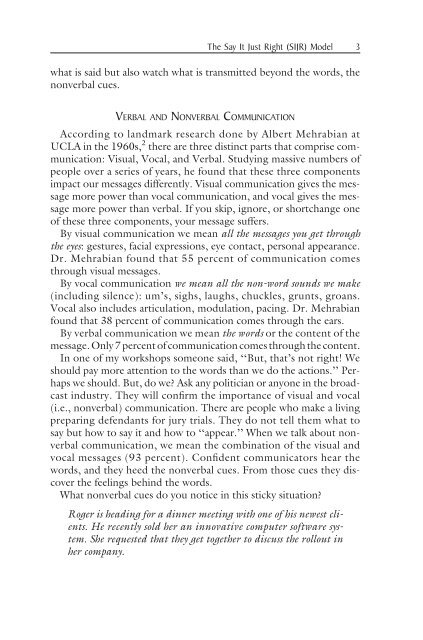Managing Sticky Situations at Work
Managing Sticky Situations at Work
Managing Sticky Situations at Work
You also want an ePaper? Increase the reach of your titles
YUMPU automatically turns print PDFs into web optimized ePapers that Google loves.
The Say It Just Right (SIJR) Model 3wh<strong>at</strong> is said but also w<strong>at</strong>ch wh<strong>at</strong> is transmitted beyond the words, thenonverbal cues.VERBAL AND NONVERBAL COMMUNICATIONAccording to landmark research done by Albert Mehrabian <strong>at</strong>UCLA in the 1960s, 2 there are three distinct parts th<strong>at</strong> comprise communic<strong>at</strong>ion:Visual, Vocal, and Verbal. Studying massive numbers ofpeople over a series of years, he found th<strong>at</strong> these three componentsimpact our messages differently. Visual communic<strong>at</strong>ion gives the messagemore power than vocal communic<strong>at</strong>ion, and vocal gives the messagemore power than verbal. If you skip, ignore, or shortchange oneof these three components, your message suffers.By visual communic<strong>at</strong>ion we mean all the messages you get throughthe eyes: gestures, facial expressions, eye contact, personal appearance.Dr. Mehrabian found th<strong>at</strong> 55 percent of communic<strong>at</strong>ion comesthrough visual messages.By vocal communic<strong>at</strong>ion we mean all the non-word sounds we make(including silence): um’s, sighs, laughs, chuckles, grunts, groans.Vocal also includes articul<strong>at</strong>ion, modul<strong>at</strong>ion, pacing. Dr. Mehrabianfound th<strong>at</strong> 38 percent of communic<strong>at</strong>ion comes through the ears.By verbal communic<strong>at</strong>ion we mean the words or the content of themessage. Only 7 percent of communic<strong>at</strong>ion comes through the content.In one of my workshops someone said, ‘‘But, th<strong>at</strong>’s not right! Weshould pay more <strong>at</strong>tention to the words than we do the actions.’’ Perhapswe should. But, do we? Ask any politician or anyone in the broadcastindustry. They will confirm the importance of visual and vocal(i.e., nonverbal) communic<strong>at</strong>ion. There are people who make a livingpreparing defendants for jury trials. They do not tell them wh<strong>at</strong> tosay but how to say it and how to ‘‘appear.’’ When we talk about nonverbalcommunic<strong>at</strong>ion, we mean the combin<strong>at</strong>ion of the visual andvocal messages (93 percent). Confident communic<strong>at</strong>ors hear thewords, and they heed the nonverbal cues. From those cues they discoverthe feelings behind the words.Wh<strong>at</strong> nonverbal cues do you notice in this sticky situ<strong>at</strong>ion?Roger is heading for a dinner meeting with one of his newest clients.He recently sold her an innov<strong>at</strong>ive computer software system.She requested th<strong>at</strong> they get together to discuss the rollout inher company.















